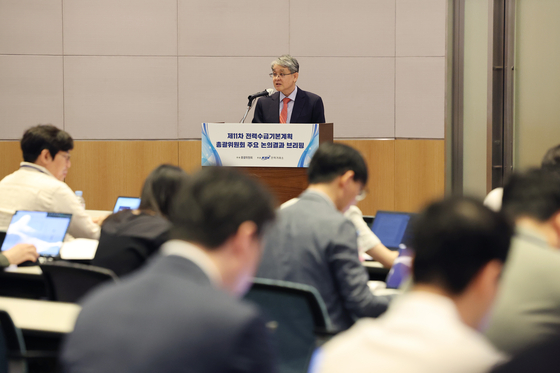Korea will build three nuclear power plants and one small modular reactor (SMR) by 2038, accelerating its deployment of nuclear power to meet rising demand for electricity.
The advisory committee to the Ministry of Trade, Industry and Energy, consisting of a team of energy experts and academics, announced the plans in its first draft of the 11th Basic Plan on Electricity Demand and Supply (BPE) in a briefing on Friday.

“It is crucial that the infrastructure for electricity be installed in a timely manner ahead of electrification,” said committee head Jung Dong-wook, a professor at Chung-Ang University and former director of the Korea Nuclear Society.
The committee has therefore proposed bumping the electricity supply generated from renewable sources and constructing nuclear generators to meet that increase in demand and Korea’s nationally determined contribution (NDC) goal made as part of the Paris Climate Agreement.
The committee lowered the targeted portion of electricity that will be generated by nuclear power in 2030 from the 32.4 percent proposed in the 10th BPE to 31.8 percent while maintaining the portion projected to be generated by renewable sources at 21.6 percent. The goal will be for nuclear power to generate 35.6 percent, and renewable energy to 32.9 percent, by 2038. Hydrogen and ammonia will account for a target of 5.5 of total power generation, meaning that more than 70 percent of energy, if goals are met, will be carbon free by 2038.
Nuclear energy took up 29.6 percent of power generation in 2022 while renewable energy accounted for 8.9 percent.
“Korea gets around 4 percent of its energy from solar panels, which has almost caught up to the global average of 5 percent. But we are still severely lacking in the area of wind power,” Jung said.
The portion attributed to coal power, meanwhile, is forecast to fall to 10.3 percent in 2038 from the 17.4 percent projected for 2030. Coal accounted for 32.5 percent of the country’s power generation in 2022, according to data from the Korea Electric Power Corporation.
The BPE is a biennial government blueprint that determines the trajectory and components of energy policy. It calculates the amount of electricity Korea is expected to use in the next 15 years and adjusts the type and number of energy sources that are needed to fulfill the amount.
The draft now has to go through an environmental impact assessment, public hearings and the National Assembly before being adopted. The project may face difficulty finding a site, however, as residents have expressed opposition due to the perceived safety risks of nuclear plants.
BY KIM JU-YEON [kim.juyeon2@joongang.co.kr]




